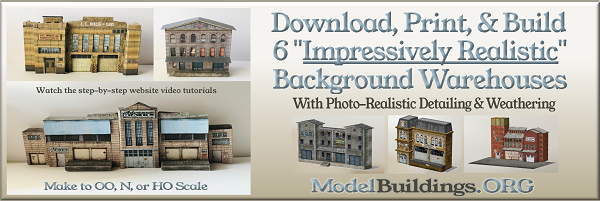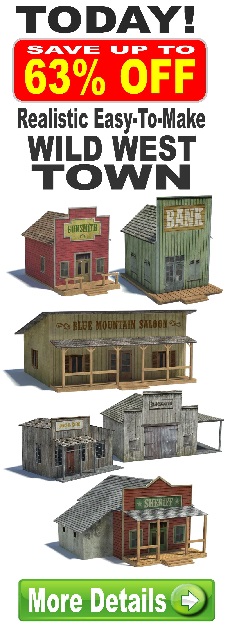Everything on model trains, model railroads, model railways, locomotives, model train layouts, scenery, wiring, DCC and more. Enjoy the world's best hobby... model railroading!
Downsizing from HO to N Scale – How to Join Modules
Alex asks readers:
“We just moved into a smaller house and I did a lot of damage to my old HO layout deconstructing and moving it. It was harder than I thought it would be. Anyway, I decided to sell off the stuff to friend and start again in N scale because I don’t have as much space. This time I’ll build it in modules, but I’m unsure what’s the best way to join them for smooth rail joins, good connections, and easy dismantling if I do another house move?”
7 Responses to Downsizing from HO to N Scale – How to Join Modules
Leave a Reply
















Hi Alex
I joined my modules together with 8mm wooden dowels one each side I drilled all the end plates all together before assembly so that they were all the same and then drilled 6mm holes to take bolts at the same time once assembled everything lines up and its all bolted together before I laid the track. I stopped the track 50mm before the end of each module and had short 100 mm pieces of track to fill the gap. as my layout is shifted from place to place on club nights the end of the track does not get damaged. being a young club we are still looking for suitable club rooms where the modules can be left set up permanently. we usually have 23 modules set up each meeting night.
If drilling through more than 2 thicknesses of wood or ply, use a pillar drill or suitable attachment to ensure the drill is absolutely vertical/at right angles to the work piece(s) in both planes.
Pattern maker’s dowels are better than wooden pegs, but expensive. DCC Concepts supply a similar product (“alignment dowels”) that might be a bit cheaper; there’s an article in the July 2016 edition of “Hornby Magazine” that shows how to fit them, although the recommended use of a pilot hole is, I think, normally superfluous when using flat drills to make the aperture and rebate. The important thing is to use the larger drill first (19 mm) to make the rebate, then use the 13 mm drill to make the deeper hole. However, you will not be able to make a series of exactly matching end boards unless you do use a small drill (2.5 mm) to drill through at least 3 pieces, thus making a template or templates for the subsequent end boards.
Alex, Good Luck in your new scale. As I learned in a club once, you want the track on your modules to end before the end of the module. I always used the rule that I would set a section of sectional track with the center on on the split of the 2 modules. A 9 inch piece for HO and for N scale what ever the length those are. The principle is the same If connecting to a club module, they will have club rules on just where these connection will be. If you are just doing them for yourself then the connections do not have to be center. These are set more toward a freemo (free modular) style and are for your inconvenience to be able to break it down easy when it comes time to move again. My HO layout is this way Basically a freemo style around the whole layout with various length of modules. So if I move or unlikely sell it it can be broke down to do it or store it.
Now as far as connecting the modules to each other dowel pins are sometimes set to slide into the next module as Kevin says, and connect the 2 with a C-clamp usually one near the front of the module and one near the rear when the height is set where you want. If your end boards are made of 1 X 3 or 1 X 4’s then a 2 inch C Clamp will do the job. Just before pulling the 2 modules together slide in your sectional track piece with connectors installed. You will power each module with wire drops attached to each track on each module so that you will have power to both sides of those connection tracks and will ensure power will get to that piece of track from at least one end. A power buss wire will follow along under your track with a disconnect where the module break down. Some use trailer wiring plugs with 4 wire capability and some use 2 wire disconnect plugs like what you might find at radio shack. You can use house hold plugs connections but don’t get them confused with house wiring and plug them into an extension cord. Use connectors that cannot be confused with other wiring.
Club modules usually have 4 legs with height adjustment bolts down against the floor to adjust the height of the track to match the connection the next module. Using the sectional track also allows a slight difference between the modules if there is some difference.
from Newman
Hi Alex;
I am 4w5a member of the Ipswich MRC N Scale in S.E.Qld. We arrange our layout in T-Trak modules. Suggest you Google Australian T-TRAK-N Guidelines, and also check out the International T-TRAK website..www.t-trak.org
That should get you on the right track
Look into T-trak, which is a creation of Kato–and an ideal system.
Before you do anything get the gen on NTrak and TTrack, both N Scale modular systems with large followings. These systems have clubs and websites and are no longer tied to any commercial entity. Then, after you’ve built you new modular N Scale layout you can take it to shows and exhibitions and it will connect to others of the same ilk and your module can become part of something big – or REAL BIG.
N is a great scale if space is an issue, but be aware that it refers to two ratios, International and British. The two sizes can be mixed without jarring the senses though. There are of course locos, rolling stock and building kits in both British, American, Japanese and European outline.
The Australian scene is improving rapidly with the input of Badger, Cocks et al – almost half the layouts displayed at the Adelaide (South Australia) last weekend were N Scale.
Read first then spend – you’ll be pleasantly surprised at what’s out there.
David
Hi Alex. Pattern makers dowels are the best way to ensure alignment each time you need to set up your layout. I use brass fittings from Station Road Baseboards. Drill a pilot hole through the baseboards and use a 25mm flat wood drill to fit the dowels. I also drill two 8/9mm holes for bolts. I have used this method on three layouts with no alignment problems. Tom